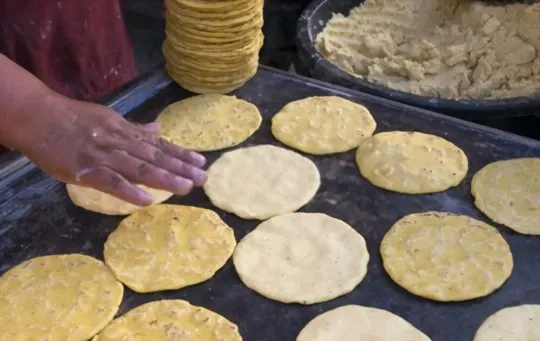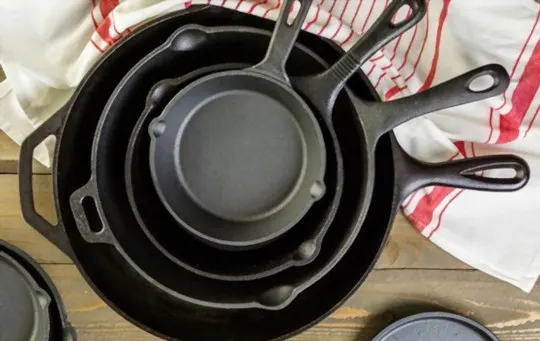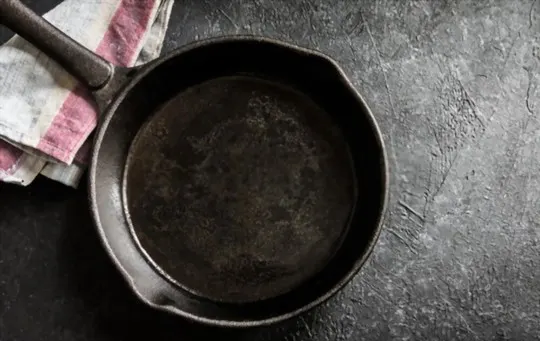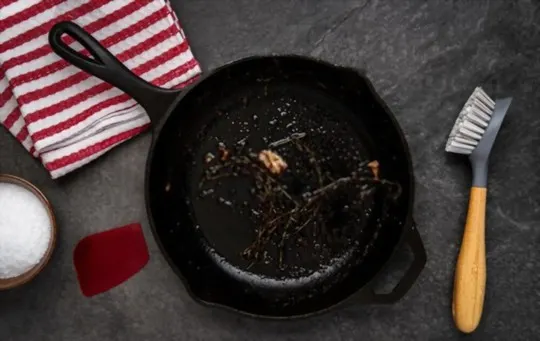In the kitchen battle of the century, we’re pitching the classic comal against the mighty cast iron skillet. Why? Because we all need to cook, and choosing the right weapon matters. The comal, with its lightweight charm, whispers of quick tacos and blistered tortillas.
The cast iron skillet, a heavyweight champ, promises seared steaks and perfect pancakes. We’ve all been there, staring at our stovetop, wondering which to grab. Our kitchens have seen it all.
I remember the first time I grabbed the skillet; it felt like lifting a small planet. Yet, it cooked my chicken to perfection. The comal? It’s my go-to for a quick quesadilla snack. Every piece has its tale in our culinary showdown.
We’re here to share ours and help you make that choice.

What is a Comal?

A Comal is a traditional Mexican cooking tool used for heating and cooking tortillas, as well as other flatbreads.
Made from clay or cast iron, it has a flat and smooth surface on which the tortilla is cooked.
The Comal is usually heated over an open fire, gas stove or electric burner before placing the tortilla on its surface.
Compared to a Cast Iron Skillet, the Comal has a larger diameter which allows for more tortillas to be cooked at once.
Additionally, the Comal’s flat surface gives the tortilla an even heat, producing a perfectly cooked piece of bread.
Furthermore, while cast iron skillets can be used for various types of cooking like frying and baking, Comals are solely intended for making tortillas.
One unique detail about using a Comal is that it adds flavor to the tortilla due to its porous material which absorbs oils and seasonings from previous usage.
Before cooking with a new Comal, it’s recommended that it be seasoned by rubbing vegetable oil onto its surface and baking it in an oven at 400 degrees Fahrenheit for about an hour.
In summary, when it comes to making tortillas or other flatbreads specifically, the Comal provides several advantages over other cookware such as cast iron skillets.
Its large diameter allows for more pieces of bread to be cooked simultaneously while also providing an evenly-heated surface that produces perfectly-cooked pieces of bread every time.
What is a Cast Iron Skillet?

Cast iron cookware is a rugged, sturdy type of cooking pan that’s an old favorite among skilled chefs.
It is made out of cast iron, which has excellent heat retention properties.
This allows it to evenly distribute heat throughout the cookware and bake dishes more efficiently.
Its thick walls and bottom make it great for searing, frying, and even baking food.
Cast iron skillets are incredibly durable and can last for generations with proper care.
They’re also rust-resistant and become non-stick over time with proper seasoning.
One unique feature of cast iron skillets is that they become non-stick after being seasoned properly.
Seasoning involves coating the pan with oil or fat and heating it at high temperatures for an extended period of time.
This creates a layer of polymerized oil on top of the metal surface that acts like natural non-stick coating as well as protecting the skillet from rusting.
In terms of cooking performance, cast iron skillets are versatile because they can be used on different types of stoves, ovens/grills, and they retain heat better than most other types of cookware.
They’re also great for outdoor cooking since their weight makes them difficult to tip over when used on open flames.
While cast iron skillets are excellent cookware in many ways, Comal serves a specific niche in Mexican cuisine where large surface areas are needed for cooking tortillas or fajitas.
Consequently, each type of cookware has its pros and cons depending on your cooking needs.
Differences Between Comal and Cast Iron Skillet

When it comes to cooking, choosing the right kind of cookware is essential.
While a comal and a cast iron skillet may seem similar, they both have their unique differences.
A comal is a round, flat cooking surface used primarily in Mexican cuisine.
It is typically made of clay or cast iron and is thinner and lighter than a cast iron skillet.
On the other hand, a cast iron skillet has thicker walls and can retain heat for longer periods of time, making it ideal for searing meats and sautéing vegetables.
Both the comal and cast iron skillet have their respective advantages depending on what is being cooked.
A comal is great for making tortillas and roasting chiles, while a cast iron skillet can evenly cook steak and create crispy edges on cornbread.
It’s important to consider what you will be cooking before deciding which cookware to use.
If you plan to cook traditional Mexican dishes or make homemade tortillas frequently, then investing in a comal may be worth it.
However, if you prefer versatile cookware that can handle various recipes and techniques, then a cast iron skillet may be the better option.
Design and Construction
The construction and design of a comal and cast iron skillet greatly impact their performance.
A comal, typically made of clay or metal, has a flat surface with raised edges, while a cast iron skillet is made entirely of thick cast iron.
The comal’s construction allows for even heat distribution, making it ideal for cooking tortillas and roasting vegetables.
Cast iron skillets have excellent heat retention properties and can be used to cook anything from eggs to steak.
Both offer distinct benefits in the kitchen but ultimately come down to personal preference and intended use.
Cooking Surface
When it comes to choosing the perfect cooking vessel, the cooking surface plays a vital role.
The type of cooking surface determines the way your food is cooked and how it tastes.
A well-prepared dish not only requires quality ingredients but also needs a proper cooking vessel.
Therefore, it is crucial to understand the importance of choosing the right cooking surface.
Cast iron skillet and comal are two popular options for home cooks.
Cast iron skillets have been around for centuries and are known for their durability, heat retention and distribution properties.
On the other hand, comals have their roots in Mexico and are known for their versatility in preparing dishes like tortillas, quesadillas, etc.
Both cast iron skillet and comal come with their unique advantages.
However, depending on your needs and preferences, one might be better than the other.
Cast iron skillets can handle high heat and are good for searing meats or frying foods.
Their non-stick surface makes cleaning easier but requires regular seasoning to avoid rusting.
Comals are perfect for low to medium temperatures and allow even cooking of food items like tortillas or vegetables.
They do not require seasoning like cast irons but may need occasional maintenance to prevent rusting.
In summary, both cast iron skillet and comal have their pros and cons depending on individual needs.
While it ultimately boils down to personal preference, understanding the unique characteristics of each can help you make an informed decision when selecting the right cooking surface.
Heat Distribution
The way heat is distributed throughout a cooking surface can greatly impact the overall cooking experience.
When comparing comal and cast iron skillets, it’s important to consider their respective methods of heat distribution.
Comals are traditionally made from heavy-gauge metals like steel or cast iron, which allow for even heat distribution across the entire surface area.
Cast iron skillets, on the other hand, may have hot spots due to their thickness and overall weight.
Despite this potential drawback, they can still offer a more controlled cooking experience with proper seasoning and maintenance.
Versatility
The versatility of both Comal and Cast Iron Skillet can’t be denied.
They both have unique characteristics that make them an excellent choice for cooking.
When it comes to versatility, the two are quite similar yet different at the same time.
Cast Iron Skillets are ideal for pan-frying or sautéing meat, vegetables or any dishes that require high heat distribution.
However, unlike Comal, Cast Iron cannot be used to cook tortillas and other flatbread without the risk of sticking or burning them due to its uneven surface.
Comal, on the other hand, is better suited for flatbreads than skillets because of its even surface which eliminates hot spots and evenly distributes heat.
Also, Comal can double as a serving dish or griddle for any food that doesn’t require high heat.
Unlike Cast Iron Skillets, Comals can be used to cook Tortillas without any fear of burning or sticking.
Similarities Between Comal and Cast Iron Skillet

The Comal and Cast Iron Skillet have many similarities, making it difficult for some to differentiate between the two.
Both feature a flat surface area that facilitates even heat distribution, which is suitable for cooking various food items.
They are forged from iron, providing optimal durability, strength and longevity as essential kitchen tools.
Although they have many similarities, there are also significant differences betweenComal and Cast Iron Skillet.
The Comal is typically broader than the skillet with a noticeably thinner profile for easy handling.
On the other hand, the Cast Iron Skillet has thicker walls with added sides to cook dishes with sauces or gravies.
One unique aspect of these utensils is that they are flexible in terms of cooking preferences.
They can be used on a stovetop, in an oven, over fire or grill flames – catering to everyone’s culinary needs and preferences without sacrificing taste and quality.
Benefits and Drawbacks of Using a Comal
A comal is a traditional flat griddle that’s widely used in Mexican cuisine.
It has its own advantages and disadvantages.
Let’s dig deeper.
When it comes to benefits, the first thing that comes to mind is versatility.
A comal can cook almost anything, from tortillas to meat, and even vegetables.
2.
it’s relatively lightweight compared to other cast-iron skillets, making it easier for daily use.
Lastly, it provides an authentic taste to your dishes by evenly heating them without losing moisture.
However, there are drawbacks too.
Cleaning a comal can be quite challenging as they are not dishwasher safe over time.
They should be seasoned regularly with oil to avoid rusting or developing an unpleasant smell.
Moreover, comals are not ideal for baking due to their lack of depth.
Although the benefits outweigh the cons in most cases, choosing between a comal and a cast iron skillet ultimately depends on personal preference and cooking needs.
Traditional Cooking Methods
Traditional cooking techniques have been around for centuries and still hold great value in today’s culinary world.
These methods often incorporate specific tools and equipment, as well as a deep understanding of heat and timing.
When it comes to choosing between a comal or cast iron skillet, each tool has its unique benefits.
A comal is a smooth, flat griddle typically used in Mexican cuisine.
It offers an even surface for cooking tortillas, meat, vegetables and other dishes that require quick and efficient heating.
On the other hand, a cast iron skillet is a versatile kitchen staple that can work wonders with various cuisines.
It retains heat exceptionally well while providing a natural non-stick surface that is perfect for searing meat or making pancakes.
Whether you opt for a comal or cast iron skillet depends on your personal preference and the type of food you plan to cook.
Each method offers different advantages that can enhance your cooking experience and produce delicious meals that are sure to impress.
Ideal Dishes
When it comes to cooking with comal or cast iron skillet, each cookware has its own benefits.
Both are ideal for specific dishes that require different types of heat and weights.
For lighter and delicate dishes such as crepes, comal is an excellent choice.
The smooth and flat surface allows even heating and distributes heat throughout the cooking process.
Whereas, a cast iron skillet is perfect for heavier dishes like steaks and fried chicken because of its heavy weight that retains heat evenly.
For versatile dishes such as fajitas, both comal and cast iron skillet can be used interchangeably.
To add an authentic charred flavor to the meat in fajitas, comal can be heated on high flame while tossing meat periodically whereas cast iron skillet will also add a unique smoky flavor to the dish when preheated before cooking.
In addition to these distinguishing factors, comals are commonly made of clay or aluminum and can also be used as serving plates or tortilla warmers because of their wide size availability.
On the other hand, cast iron skillet is easy to maintain and usually lasts a lifetime if taken care of properly.
With all said above, choosing between comal and cast iron skillet solely depends on the type of dish you’re cooking.
Furthermore, experimenting with different cookware can elevate your cooking experience by discovering new flavors in traditional recipes without compromising authenticity.
Maintenance and Care
Maintaining your cookware is vital for its longevity.
Long-lasting kitchen appliances translate to economical and efficient cooking investment.
To care for both the comal and cast iron skillet, always keep your pans dry, seasoned, and away from harsh cleaning agents.
Do not submerge them in water for extended periods or place them in a dishwasher that can strip off layers of seasoning coating.
Regularly check the surface for rusting and re-season immediately if any signs appear.
Furthermore, ensure that you use heat-resistant equipment when handling your cookware to avoid scratching or damaging their surfaces.
Always store your pans in a dry area with ample ventilation to reduce moisture buildup on their surfaces.
It is also wise to take note of the differences between cleaning raw iron cookware such as cast iron skillets versus comals, which are traditionally fashioned from cast metals such as aluminum, steel, brass or copper-based alloys like bronze or brass’.
Cast iron needs more attention than most other kinds; however, maintenance routines remain relatively similar.
By following these guidelines coupled with regular use of your comal or cast iron skillet appropriately will ensure it lasts for many years while providing excellent culinary experiences.
Benefits and Drawbacks of Using a Cast Iron Skillet
When it comes to selecting the best cookware, a Cast Iron Skillet is one of the most favored choices.
It is notoriously famous for its durability and evenly heating properties.
So, what are the advantages and disadvantages of using a Cast Iron Skillet?
- The first benefit of using a Cast Iron Skillet is that it is virtually indestructible. It can last for decades with proper care, making it an excellent value for money.
- Cast Iron Skillets are known to offer even heat distribution, which makes them ideal for searing meats and frying food. Moreover, they hold heat well which means that your meal stays warm on the table.
- On the downside, Cast Iron Skillets require some upkeep since they need to be seasoned before every use and cleaned with special care afterward. They are also prone to rusting if not maintained properly.
It’s worth noting that choosing between a Comal vs Cast Iron Skillet depends on the type of cooking you intend to do.
While Comal is best suited for making tortillas and grilling vegetables due to its non-stick surface; Cast Iron Skillets work better for dishes such as steak or fried chicken.
Ultimately, the choice between these two cooking options depends on personal preferences and specific needs in the kitchen.
Conclusion
Analyzing the efficiency of both cookware, it’s evident that both Comal and Cast Iron Skillet are excellent choices for cooking.
The preference varies depending on the type of meal and one’s personal taste.
Furthermore, before deciding which cookware is suitable for your needs, consider factors like size, weight, and what you’ll be using it for.
If you’re looking to make tortillas or tacos in bulk, a Comal would be perfect.
If you’re after versatility and durability in handling different meals with varying cooking times, then Cast Iron Skillet would be more convenient.
Overall, whichever option you choose between the two cookware depends solely on individual preferences when preparing delicious meals.
